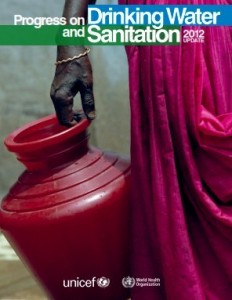3月22日「世界水日2012」 農村食水及衞生亟需關注 婦女及女童受害最深
2012-03-22
紐約/香港,2012年3月22日——聯合國兒童基金會(UNICEF)在今日「世界水日」,呼籲各國政府需分外關注並未受惠於國家及經濟發展的農村人口,他們不少至今仍未取得安全食水及得到基本公共衞生設施。並指出食水短缺帶來種種問題,而婦女及女童往往是受害最深的一群。
「各國政府必應確保社會資源分配均衡,令最貧困人口都能分享到國家發展成果。」UNICEF供水、公共及個人衞生項目主任Sanjay Wijesekera表示:「否則,各地政府將會承受大量國民,尤其是兒童,面對疾染不堪一撃的風險。」

UNICEF及世界衞生組織於兩周前共同發表的《2012年飲用水和衞生設施進展》指出,截至2010年底,全球89%的人口,即61億人使用經改善的飲用水源,成功實踐了「千禧發展目標(Millennium Development Goal)」。不過,卻出現了全球性的城市與農村安全飲用水人口不均的問題——未能獲得安全飲用水的農村人口足較居住在城市的多出好幾倍。
2010年,全球約有7.8億人缺乏經改善的飲用水源,當中多達超過8成(即6.5億人)屬農村人口。公共衞生方面更是差強人意,環顧全球,可使用經改善的公共衞生設施的城市人口比率達79%,但農村的卻只得47%。換言之,未能使用經改善公共衞生設施的人口中,多達72%是居住在農村地區的人口,亦即18億人。
UNICEF更發現,在貧窮國家出現的安全飲用水不均問題,情況更為嚴峻。以撒哈拉以南的非洲地區為例,城市與鄉村在獲取安全飲用水的比率差距高達34%。而在發展最緩慢的國家中,平均而言,每100名農村人口,只得3人住所備有供水設施。
UNICEF坦言,食水短缺帶來種種問題,婦女及女童往往是最受影響的一群。在25個撒哈拉以南非洲國家進行的調查發現,71%缺乏供水設施的家庭,均由家中母親和女孩負起挑水的重擔。每個家庭,每日最少要為取水遠走一趟,若要取得足夠一日所需的水量,她們甚至要來回奔走幾遍。粗略估計,全球婦女每天合共花上至少1,600萬小時擔水,男人則花上600萬小時,即使是年幼的兒童亦花達400萬小時。
「每一個人,都應該獲得安全食水。」Wijesekera先生表示:「我們無法滿足於目前成果,除非有一天,我們看到最難接觸的一群,他們只要扭開水龍頭,或到水井或水泵,輕鬆便取得足夠一日所需的安全食水。」
![On 5 August, Kurfa Wario draws water from a collection tank in the ground, in Melbana Village, Mio District, in the drought-affected Borena Zone. The collection tank has just been filled by a tanker truck delivering emergency water supplies. Water delivery is supported by the Borena Zone Emergency Water Taskforce, of which UNICEF is a member. [#6 IN SEQUENCE OF NINE] In late August 2011, the crisis in the Horn of Africa affecting primarily Kenya, Somalia, Ethiopia and Djibouti continued, with a worsening drought, rising food prices and ongoing conflict in Somalia. The regions worst drought in 60 years has left 12.4 million people in need of assistance, including 4.8 million in Ethiopia. The Government of Ethiopia estimates that 150,000 children under age five will require treatment for severe acute malnutrition, a deadly condition, by the years end. In addition, over 76,000 refugees from Somalia which faces one of the worlds severest food security crises have entered Ethiopia, with a further 200 to 300 arriving every week. Many refugees are dangerously malnourished, and death rates among refugee children have reached alarming levels, according to the United Nations High Commissioner for Refugees (UNHCR). Meanwhile, emergency food reserves are dwindling, and outeaks of measles have been reported in refugee camps. UNICEF, together with the Government, United Nations, NGO and community partners, is supporting a range of interventions and essential services, especially for the displaced and for refugees, including feeding programmes, immunization campaigns, health outreach, and access to safe water and to improved sanitation. A joint United Nations appeal for humanitarian assistance for the region requires US $2.4 billion, of which 58 per cent has been received to date. A majority of UNICEFs portion of the appeal has been funded.](/wp-content/uploads/2015/12/20120322_WWD2-300x214.jpg)










